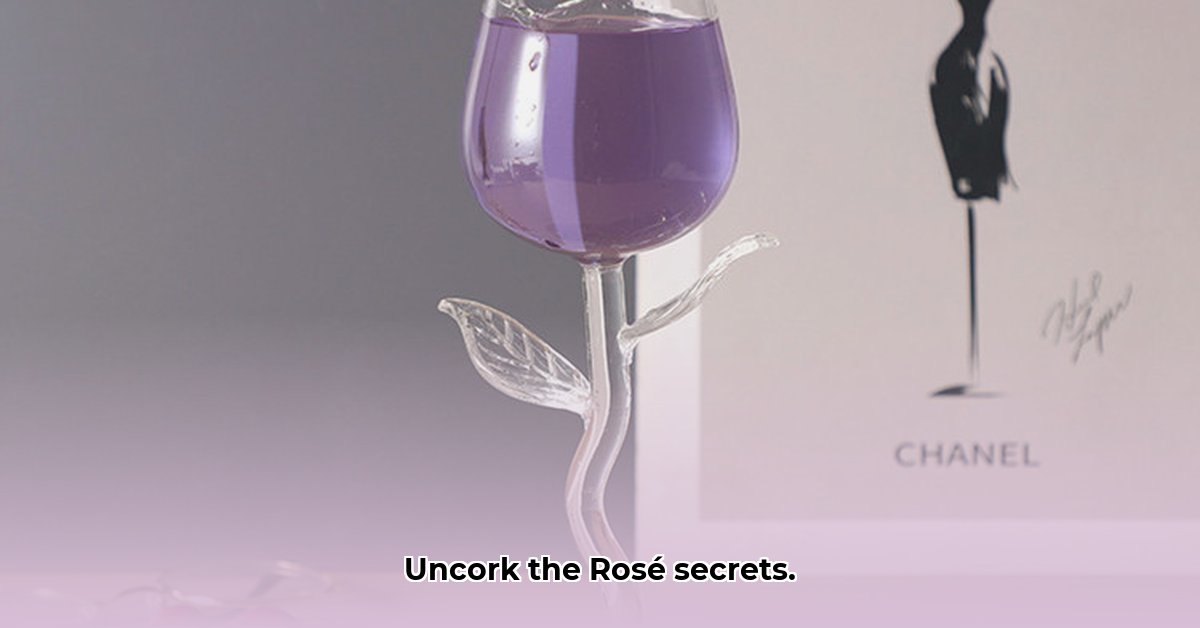Selecting the right wine glass can significantly enhance your drinking experience, and this is especially true for rosé. It’s about optimizing the wine’s flavors and aromas, not just being fancy. This guide will help you choose the perfect rosé glass, covering everything from shape to stem and material. You’ll learn how to pick a glass that enhances both the taste and presentation of your rosé, allowing you to enjoy it like a true connoisseur.
Understanding the Impact of Rosé Wine Glass Selection
Choosing the right glass for your rosé profoundly affects how you perceive its taste and aroma. The right glass elevates the wine, while the wrong one can diminish its qualities. Let’s explore the key factors that make a rosé glass exceptional.
Exploring the Key Design Factors: Shape, Size, and More
The shape of the glass bowl is crucial. A bowl that is wider at the bottom and gently tapers towards the top allows the rosé’s delicate aromas to develop and concentrate. This design provides enough surface area for the wine to breathe, enhancing the release of volatile compounds that contribute to its unique scent profile. A narrower bowl, resembling a tulip, is ideal for rosés with more intense aromas, as it helps to focus these scents and deliver them directly to your nose.
The rim of the glass also plays a significant role. A thin rim ensures a smooth, uninterrupted flow of wine onto your palate, allowing you to fully appreciate its nuances. A thicker rim, while more durable, can sometimes distract from the wine’s delicate flavors.
Stemmed vs. Stemless: Evaluating Your Glassware Options
The choice between stemmed and stemless glasses is largely a matter of personal preference. Stemmed glasses offer the advantage of keeping your hand from warming the wine, preserving its ideal temperature. They also tend to have a more formal appearance. Stemless glasses, on the other hand, are more casual and less prone to tipping, making them suitable for relaxed gatherings.
Comparing Glass Materials: Quality and Durability
Crystal glasses are prized for their clarity and elegance, enhancing the visual appeal of the wine. The way light reflects off crystal can make the rosé appear more vibrant and inviting. However, crystal is more expensive and fragile than standard glass. Standard glass glasses are a practical and affordable option, offering good durability for everyday use.
Pairing Rosé Styles with Ideal Glass Shapes
Different styles of rosé benefit from different glass shapes. Here’s a guide to help you make the best choice:
| Rosé Style | Recommended Glass Shape | Why It Works |
|---|---|---|
| Light-bodied, dry | Narrow bowl, tulip shape | Concentrates delicate aromas and highlights the wine’s acidity. |
| Medium-bodied, dry | Moderately wide bowl, tapered | Balances aroma development with delicate notes. |
| Full-bodied, fruity | Wide bowl, flared lip | Enhances the rich fruit flavors and aromatic complexity. |
| Sparkling Rosé | Flute or coupe | Preserves the bubbles and enhances presentation. |
Selecting Your Glass: A Detailed Guide
- Know Your Rosé: Determine the body, sweetness, and dominant aromas of your preferred rosé.
- Stem or No Stem? Consider the setting where you’ll typically enjoy your rosé.
- Crystal or Glass? Evaluate your budget and desired level of elegance.
- Choose Your Bowl Wisely: Select a bowl shape that complements your rosé’s character.
- The Taste Test: Experiment with different glasses to find the one that best enhances your rosé.
Finding the perfect rosé glass is a personal journey. Don’t hesitate to experiment and trust your palate.
Decoding the Impact of Rosé Wine Glass Shapes
The shape of your rosé glass plays a significant role in your overall tasting experience. It’s not just about aesthetics; different shapes enhance aroma release and flavor perception. Understanding these nuances can transform your appreciation of rosé.
The Shape of Things: Key Elements and Their Impact
Rosé, known for its delicate balance of fruit and acidity, benefits from a glass designed to showcase its unique qualities. The key elements to consider are the bowl’s size and shape, the rim’s width, and the presence or absence of a stem.
Unlocking Aromatic Intensity with Bowl Shape
A wider bowl allows for greater oxygen exposure, enhancing the release of aromatic compounds. This is ideal for bolder rosé styles, which benefit from the раскрытие of their complex layers. For lighter, more delicate rosés, a narrower bowl helps preserve the subtle nuances, preventing the aromas from dissipating too quickly.
Fine-Tuning Flavor Delivery on Your Palate
The rim’s width influences the wine’s flow onto your tongue. A slightly tapered rim directs the rosé towards the center of your tongue, highlighting its fruitiness and acidity. A wider rim provides a more direct and intense experience.
Maintaining Temperature: Stemmed vs. Stemless
Stemmed glasses prevent your hand’s warmth from affecting the wine’s temperature, which is crucial for maintaining its optimal chill. Stemless glasses are more casual but may warm the wine more quickly.
Pairing Rosé Styles with the Right Glass
To maximize your enjoyment, consider these pairings:
| Rosé Style | Recommended Glass Shape | Rationale |
|---|---|---|
| Light, delicate rosé | Narrower bowl, tulip shape | Preserves delicate aromas; concentrates the bouquet. |
| Medium-bodied rosé | Slightly wider bowl, slightly tapered rim | Balances aroma release with flavor delivery. |
| Bold, fruit-forward rosé | Medium to wide bowl, possibly a slightly flared rim | Allows maximum aroma expression and showcases the wine’s rich fruit character. |
By paying attention to these details, you can significantly elevate your rosé enjoyment.
Mastering the Art of Choosing a Rosé Glass
Matching Glassware to Rosé Style for Maximum Enjoyment
Before selecting a glass, consider the diversity of rosé. From delicate Provençal styles to bolder, fuller-bodied varieties, each exhibits unique aromatics and textures. The right glass optimizes the sensory experience, considering both the wine and your personal preferences.
Exploring Flavor Profiles and Bowl Shapes
The ideal rosé glass typically features a moderately wide bowl, often described as tulip-shaped. This design gently gathers aromas and directs them towards your nose, while the slightly flared rim allows for sufficient air contact to unlock the wine’s flavors.
Temperature Control: Stemmed vs. Stemless
Stemmed glasses prevent hand warmth, preserving the wine’s crispness, while stemless options offer modern convenience. The choice is a personal one.
- Gray Kitchen Backsplash Tile: Ideas for a Stylish Upgrade - December 14, 2025
- Backsplash For Gray Cabinets: Choosing the Right Backsplash Style - December 13, 2025
- Gray And White Backsplash: Ideas For Timeless Style - December 12, 2025









